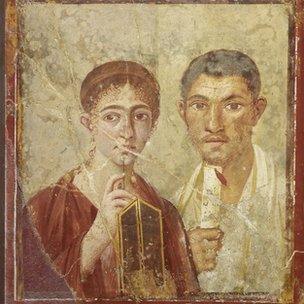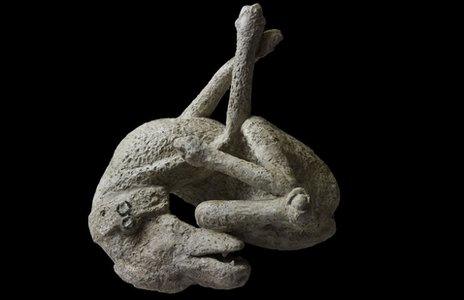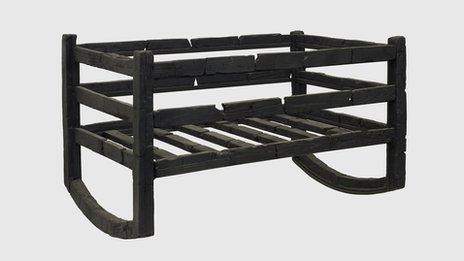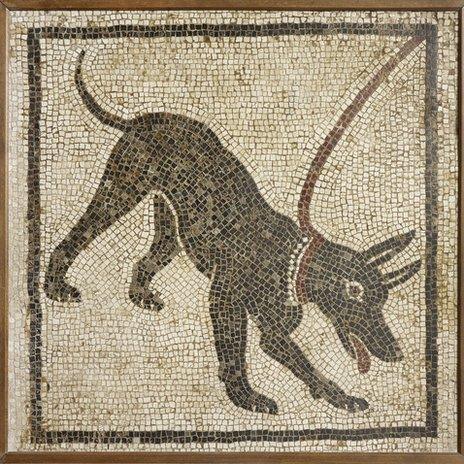British Museum explores domestic life in Pompeii
- Published
Arts Editor Will Gompertz and Margaret Mountford take a look at the exhibition
The British Museum's latest exhibition aims to show that domestic life in the Roman Empire wasn't so different to how we live now.
When Mount Vesuvius erupted in AD79, showering hot volcanic ash on to Pompeii and Herculaneum, it created a time capsule that lay undiscovered for almost 1,700 years.
Among the treasures that have emerged from the buried streets and houses is a fresco of the bakery owner Terentius Neo and his wife (see picture).
He grips a papyrus scroll with a wax seal. She holds a stylus to her chin and carries a writing tablet. Both gaze out from the painting with large, almond-shaped eyes.

Wall painting of the baker Terentius Neo and his wife - Pompeii, AD50 to 79. Copyright Soprintendenza Speciale per i Beni Archeologici di Napoli e Pompei / Trustees of the British Museum
The double portrait - the only one of its kind to have been found in the area - is one of the highlights of the British Museum's Life and Death in Pompeii and Herculaneum, external which opens this week.
Paul Roberts, the exhibition's curator, says the painting offers a unique insight into the life of Pompeii's citizens in the 1st century AD.
"The baker and his wife are shown as good Romans, the scroll and the stylus shows they are literate and cultured. But the most important thing is that they seem to be treated as equal partners.
"She is standing slightly forward of him: this is not a subservient image of a woman. In this business, she's the one holding the reckoning tablet."
After five years of preparation, Roberts has brought together 400 objects that focus on the lives - and deaths - of the citizens of Pompeii and Herculaneum. It is the first time the British Museum has dedicated a show to the two ill-fated cities.
Most of the works have come to London as a result of close collaboration with the Archaeological Superintendency of Naples and Pompeii. Many have never travelled outside Italy before.

Plaster cast of a dog. From the House of Orpheus, Pompeii, AD79
With the focus on domestic - rather than city - life, the exhibition's more unusual items include kitchen perishables such as figs, dates, walnuts and onions. There is even a loaf of bread that had been baking in the oven as the city was engulfed by ash.
"I think visitors will be interested in the similarities between Roman domestic life and today," says Roberts.
"I want people to come away feeling that they got closer to the Romans here than they do by watching films that have gladiators."
Objects are displayed within rooms that recreate the lay-out of a typical house in Pompeii or Herculaneum. Items of furniture on view include a linen chest, a garden bench and a baby's crib that still rocks on its curved feet.

Carbonised wooden cradle. From the House of M.P.P.Granianus, Herculaneum, 1st century AD
The exhibition includes casts from Pompeii of some of the victims of the eruption. About 1050 bodies have so far been discovered in Pompeii. The ash hardened around their corpses, which rotted away to leave body-shaped voids from which casts have been made.
One of the first objects in the exhibition is the plaster cast of a struggling dog. The final section includes a family of two adults and their two children huddled together in their last moments under the stairs of their villa.
The British Museum has put an age warning on some exhibits - such as a statue of the god Pan having sexual intercourse with a goat - to reflect the explicit imagery that was an accepted feature of ancient Roman culture.
What of the smallest room in the house? The exhibition features two bedroom potties but Roberts notes that the toilet was usually situated in the kitchen - a convenient disposal point for both food and human waste.

Mosaic of a guard dog. From the House of Orpheus, Pompeii, 1st century AD
"They threw everything down the toilet. When we were photographing the houses for the catalogue I was amazed at how many times you'd find the big cooking platforms right next to a depression which is all that remains of the hole that goes down to the septic tank."
In 2007 archaeologists in Herculaneum found a huge cesspit containing toilet and household waste that had been deposited in the decade before it was sealed by the eruption.
"There were 750 sacks of human waste, as you might expect," explains Roberts, "but what they didn't expect was the massive quantity of pots and pans and jewellery and terracotta statuettes.
"What I like about this exhibition is that as a museum of art and archaeology we have beautiful mosaics and the painting of the baker and his wife - but we also have the contents of a drain!"
Life and Death in Pompeii and Herculaneum opens at the British Museum on 28 March and runs until 29 September. Cinema broadcast Pompeii Live takes place on 18 and 19 June.
- Published7 February 2013
- Published23 November 2012
- Published20 September 2012
- Published15 June 2011